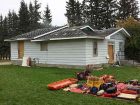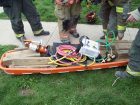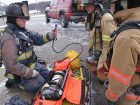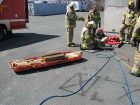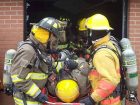
Back to Basics: October 2015
Mark Van
Features Fire Ground TrainingIn the world of technical rescue, the Stokes basket is a main piece of equipment. The basket is used for patient packaging and transfer from one elevation to another during a rope rescue, confined-space rescue, or even water rescue if it is equipped with floatation devices. Many fire departments carry Stokes baskets on their fire trucks for rescue scenarios, but this versatile piece of equipment is also valuable for the rapid intervention team (RIT).
A RIT operation requires that many different types of tools and equipment be gathered and staged. The wish list of equipment is shown in photo 1, but the Stokes basket benefits a fire department the most when there is minimal equipment – a RIT kit, a set of hand tools such as the Haligan and flat-head axe, a thermal-imaging camera and a search-rope bag.
When two firefighters are assigned to set up RIT, their first step is to gather all the needed equipment from the fire truck or trucks. Instead of making multiple trips, the Stokes basket can be used to carry all the equipment at once to the staging area. As shown in photo 2, all the necessary equipment is in one place and ready for quick deployment. The Stokes basket keeps the equipment together and out of the way of other operations; it also makes it easier to move the RIT staging area to a different location if need be.
Depending on the type of rescue, specialized or technical rescue equipment may be needed during the RIT’s deployment. For example, if a lift operation is required, the team will need air bags, cribbing and possibly portable hydraulic spreaders. All of this equipment is too much for one or two RIT firefighters to carry at once. The Stokes basket can be loaded up with the required equipment as shown in photo 3 and then carried into the structure by two or three RIT firefighters.
If more cribbing is required during a lifting operation, the basket can be sent back out, reloaded (see photo 4), and then brought back inside.
Before bringing in equipment, be sure to connect all the air hoses, test them and have full cylinders so that when they are used inside, there is no wasted time trying to make the connections in a limited-visibility environment.
A downside to using the Stokes basket for deploying equipment is its size. The basket is about six feet long and does not bend so going around corners can be tricky. The Stokes, therefore, is not the best option if the structure’s layout involves many tight corners.
A benefit of using the Stokes basket to deploy equipment is that it can be slid along the floor. A rope system can also be used to help guide and pull the basket. A good option is the simple 2:1 mechanical advantage system, which involves a rope, a set of pulleys and carabineers, a ground ladder and a guiding crew. See the July 2013 issue of Canadian Firefighter for a more detailed description of the 2:1 mechanical-advantage system.
Once a downed firefighter has been freed from any obstructions and is ready for removal, a Stokes basket is then used as the transport device for which it was originally designed. As shown in photo 5, the downed firefighter can be easily removed through enlarged openings by a team on the inside passing the basket out to a team waiting on the outside. This operation can be accomplished with as few as two RIT firefighters but is best accomplished with at least four. A team of four firefighters ensures the basket is balanced during the transfer from the inside to the outside.
Securing the downed firefighter to the Stokes basket, as is done in rope or confined-space rescue, is optional. Time is the essential factor for the downed firefighter and getting him or her medical attention is the priority.
If your fire truck has a Stokes basket, be sure to grab it and make it a part of your RIT-staging equipment.
Mark van der Feyst has been in the fire service since 1999 and is a full-time firefighter in Ontario. He teaches in Canada, the United States and India and is the lead author of Residential Fire Rescue. Mark@FireStarTraining.com
Print this page
